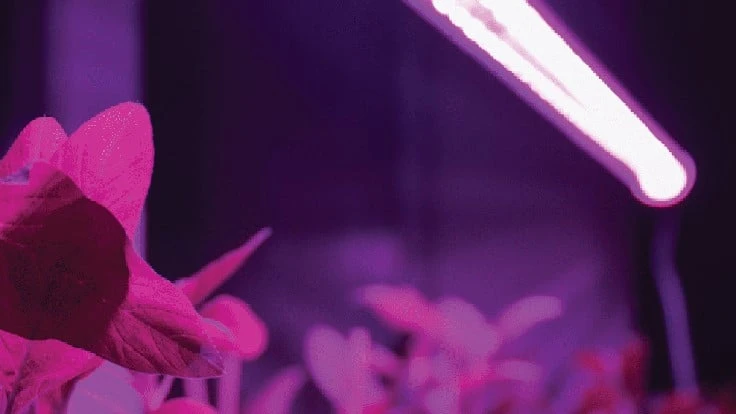

After 40 years of supporting Canadian greenhouse growers, the annual Canadian Greenhouse Conference returned in 2021.
Two lighting-focused sessions that caught our attention were “Optimizing Orius Performance in Greenhouses” by Dr. Rose Labbe, greenhouse entomologist at the Agriculture and Agri-Food Canada’s Harrow Research and Development Centre, and “Modifying Parasitoid Behaviour with Artificial Light to Improve Biological Control of Aphids” by Jessica Fraser, a master’s student in plant biology at the University of Laval. Both sessions featured information about LED lighting that growers can use in their greenhouses.
It’s well known that LED lights are crucial components for many greenhouses that operate in areas that don’t get sufficient natural light for their crops. But LEDs can also affect insects, too, and that’s what these two researchers set out to investigate.
Labbe on Orius effects
Labbe and her research team are working to identify both the most effective and sustainable ways to manage the diversity of pests present within Canada’s greenhouse and vertically farmed crops. In her talk, she shared how LED light can make Orius species perform more effectively. Being predators of more than 20 different insect species, Orius bugs can be valuable to growers in need of control agents against thrips, whitefly, lepidoptera and more. If LED light enhances the effectiveness of Orius species predators against pests in greenhouses and vertical farms, growers will have another tool in their pest-fighting arsenal.
Labbe found that Orius species do in fact respond to selective light spectra. Specifically, blue light was the most stimulating to Orius laevigatus, while violet light was most stimulating to Orius insidiosus, “suggesting that short wavelength of light has the power to better manipulate physiological and behavioral responses in insects.” Labbe also noted that, while not observed in the study, it is possible that in short-day seasons, high-intensity green LED light could improve Orius population growth.
Of course, the work of researchers is never really finished, and Labbe says there is more that needs to be done. Going forward, Labbe says that “future work should evaluate performance of O. insidiosus from different latitudes,” as an Orius’ latitude of origin affects its development. According to the researcher, there is still a great deal of investigation to do, but “the future is bright for lighting and arthropod research as the Canadian greenhouse industry continues to produce better and more effective lighting conditions for both improved crop production as well as effective year-round crop protection.”

LEDs and parasitoids
Fraser shared her master’s research on how LED light can change the ways parasitoids and their pest hosts behave. Fraser set out to experiment using LEDs to test different lengths of day extensions as well as different colors of light. If Fraser finds an LED regime that benefits both crops and parasitoids, but doesn’t benefit the pests, then the parasitoids can potentially control pests more effectively. This would mean that growers would be able to implement the LED regime in their greenhouses to help control pests and protect their plants.
Fraser and her team chose the wasp Aphidius matricariae as the parasitoid, the green peach aphid Myzus persicae as the pest host and the bell pepper Capsicum annuum as the crop.
Fraser and her team found that aphids didn’t respond to the LED light in any observable way, but the wasps did respond. Under broad spectrum white and red/green/blue (RGB) extended days, female wasps increased their activity. Males’ activity, on the other hand, increased under red/blue (RB) extended days. Fraser also determined that “shorter day extensions may promote more activity [in wasps] than longer ones.” These results of increased activity in the parasitoid wasps with no benefit to the aphids indicate that a light regime with a short white, RGB or RB day extension might increase the wasps’ biocontrol effectiveness.
And although Fraser says that “it’s still unclear how this will affect the wasps and their hosts at the population level, and whether this will change biocontrol outcomes,” she plans to keep exploring the subject.
Both Labbe’s and Fraser’s research offer promising results for growers looking for new ways to control pests in their greenhouses. Since many operations already employ LED lights in their greenhouses to aid in plant growth, using them as a biocontrol tool could be a great way for growers to get the most out of their investment.

Explore the November 2021 Issue
Check out more from this issue and find your next story to read.
Latest from Greenhouse Management
- Anthura acquires Bromelia assets from Corn. Bak in Netherlands
- Top 10 stories for National Poinsettia Day
- Langendoen Mechanical hosts open house to showcase new greenhouse build
- Conor Foy joins EHR's national sales team
- Pantone announces its 2026 Color of the Year
- Syngenta granted federal registration for Trefinti nematicide/fungicide in ornamental market
- A legacy of influence
- HILA 2025 video highlights: John Gaydos of Proven Winners





